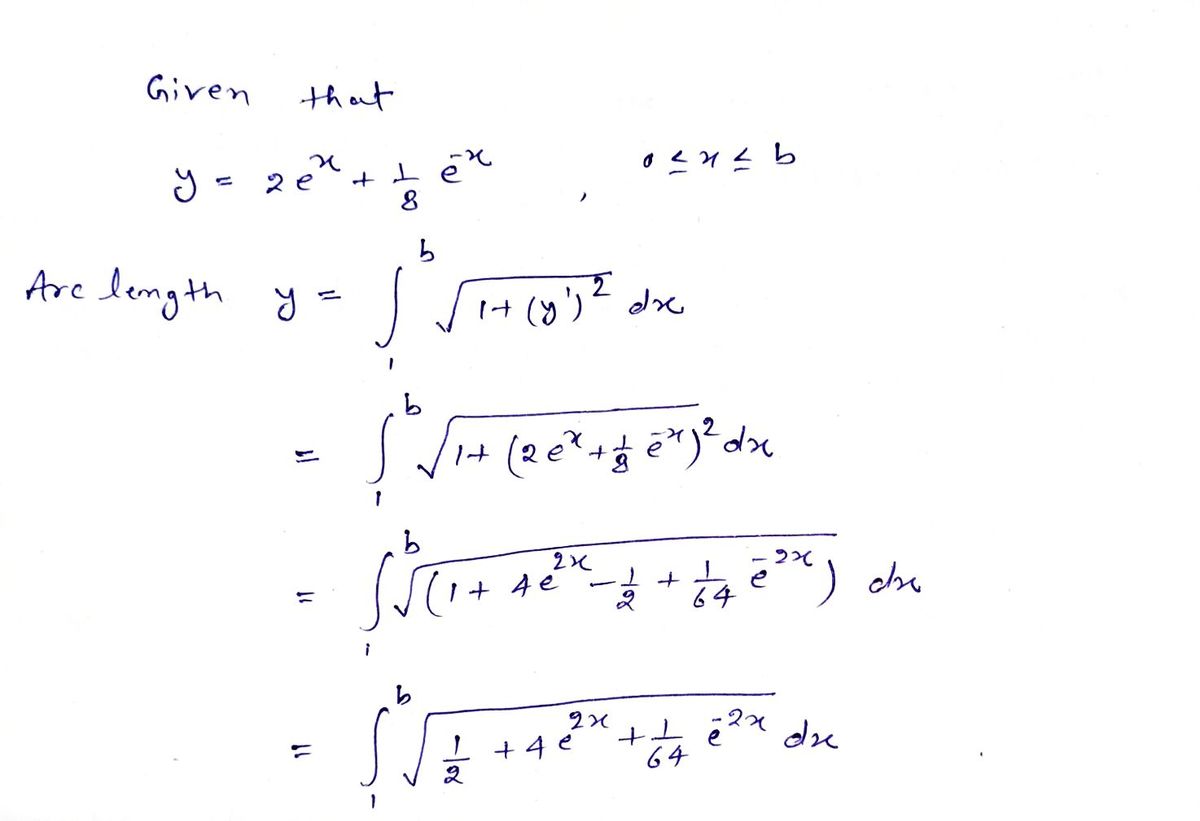Complete the steps needed to find the arc length of the following function. 1 y = 2² +²e=²₁ 0≤ x ≤b 0≤x≤ е 8 b L = - Lºv √ 1 + (y) ² dx =-1₁° v 1+ (2e² - e-²) ² dx 1 е 8 1 64 =√₁² √ =... 1+ (4e² - 1 2 + -e-²x) dx
Complete the steps needed to find the arc length of the following function. 1 y = 2² +²e=²₁ 0≤ x ≤b 0≤x≤ е 8 b L = - Lºv √ 1 + (y) ² dx =-1₁° v 1+ (2e² - e-²) ² dx 1 е 8 1 64 =√₁² √ =... 1+ (4e² - 1 2 + -e-²x) dx
Calculus: Early Transcendentals
8th Edition
ISBN:9781285741550
Author:James Stewart
Publisher:James Stewart
Chapter1: Functions And Models
Section: Chapter Questions
Problem 1RCC: (a) What is a function? What are its domain and range? (b) What is the graph of a function? (c) How...
Related questions
Question
![**Complete the steps needed to find the arc length of the following function.**
Given the function:
\[ y = 2e^x + \frac{1}{8}e^{-x}, \quad 0 \leq x \leq b \]
The arc length \( L \) is calculated by the formula:
\[ L = \int_{1}^{b} \sqrt{1 + (y')^2} \, dx \]
**Steps:**
1. Substitute the derivative \( y' \):
\[ L = \int_{1}^{b} \sqrt{1 + \left(2e^x - \frac{1}{8}e^{-x}\right)^2} \, dx \]
2. Simplify the expression inside the integral:
\[ = \int_{1}^{b} \sqrt{1 + \left(4e^{2x} - \frac{1}{2} + \frac{1}{64}e^{-2x}\right)} \, dx \]
3. Continue with further simplification and integration as needed.](/v2/_next/image?url=https%3A%2F%2Fcontent.bartleby.com%2Fqna-images%2Fquestion%2Fc1913c9c-da59-4e5e-af1e-78b6351c7d9b%2Fa17bfc1c-b318-4641-807f-604debcc4341%2Faqbhqel_processed.jpeg&w=3840&q=75)
Transcribed Image Text:**Complete the steps needed to find the arc length of the following function.**
Given the function:
\[ y = 2e^x + \frac{1}{8}e^{-x}, \quad 0 \leq x \leq b \]
The arc length \( L \) is calculated by the formula:
\[ L = \int_{1}^{b} \sqrt{1 + (y')^2} \, dx \]
**Steps:**
1. Substitute the derivative \( y' \):
\[ L = \int_{1}^{b} \sqrt{1 + \left(2e^x - \frac{1}{8}e^{-x}\right)^2} \, dx \]
2. Simplify the expression inside the integral:
\[ = \int_{1}^{b} \sqrt{1 + \left(4e^{2x} - \frac{1}{2} + \frac{1}{64}e^{-2x}\right)} \, dx \]
3. Continue with further simplification and integration as needed.
Expert Solution
Step 1: Given that

Step by step
Solved in 3 steps with 2 images

Recommended textbooks for you

Calculus: Early Transcendentals
Calculus
ISBN:
9781285741550
Author:
James Stewart
Publisher:
Cengage Learning

Thomas' Calculus (14th Edition)
Calculus
ISBN:
9780134438986
Author:
Joel R. Hass, Christopher E. Heil, Maurice D. Weir
Publisher:
PEARSON

Calculus: Early Transcendentals (3rd Edition)
Calculus
ISBN:
9780134763644
Author:
William L. Briggs, Lyle Cochran, Bernard Gillett, Eric Schulz
Publisher:
PEARSON

Calculus: Early Transcendentals
Calculus
ISBN:
9781285741550
Author:
James Stewart
Publisher:
Cengage Learning

Thomas' Calculus (14th Edition)
Calculus
ISBN:
9780134438986
Author:
Joel R. Hass, Christopher E. Heil, Maurice D. Weir
Publisher:
PEARSON

Calculus: Early Transcendentals (3rd Edition)
Calculus
ISBN:
9780134763644
Author:
William L. Briggs, Lyle Cochran, Bernard Gillett, Eric Schulz
Publisher:
PEARSON

Calculus: Early Transcendentals
Calculus
ISBN:
9781319050740
Author:
Jon Rogawski, Colin Adams, Robert Franzosa
Publisher:
W. H. Freeman


Calculus: Early Transcendental Functions
Calculus
ISBN:
9781337552516
Author:
Ron Larson, Bruce H. Edwards
Publisher:
Cengage Learning